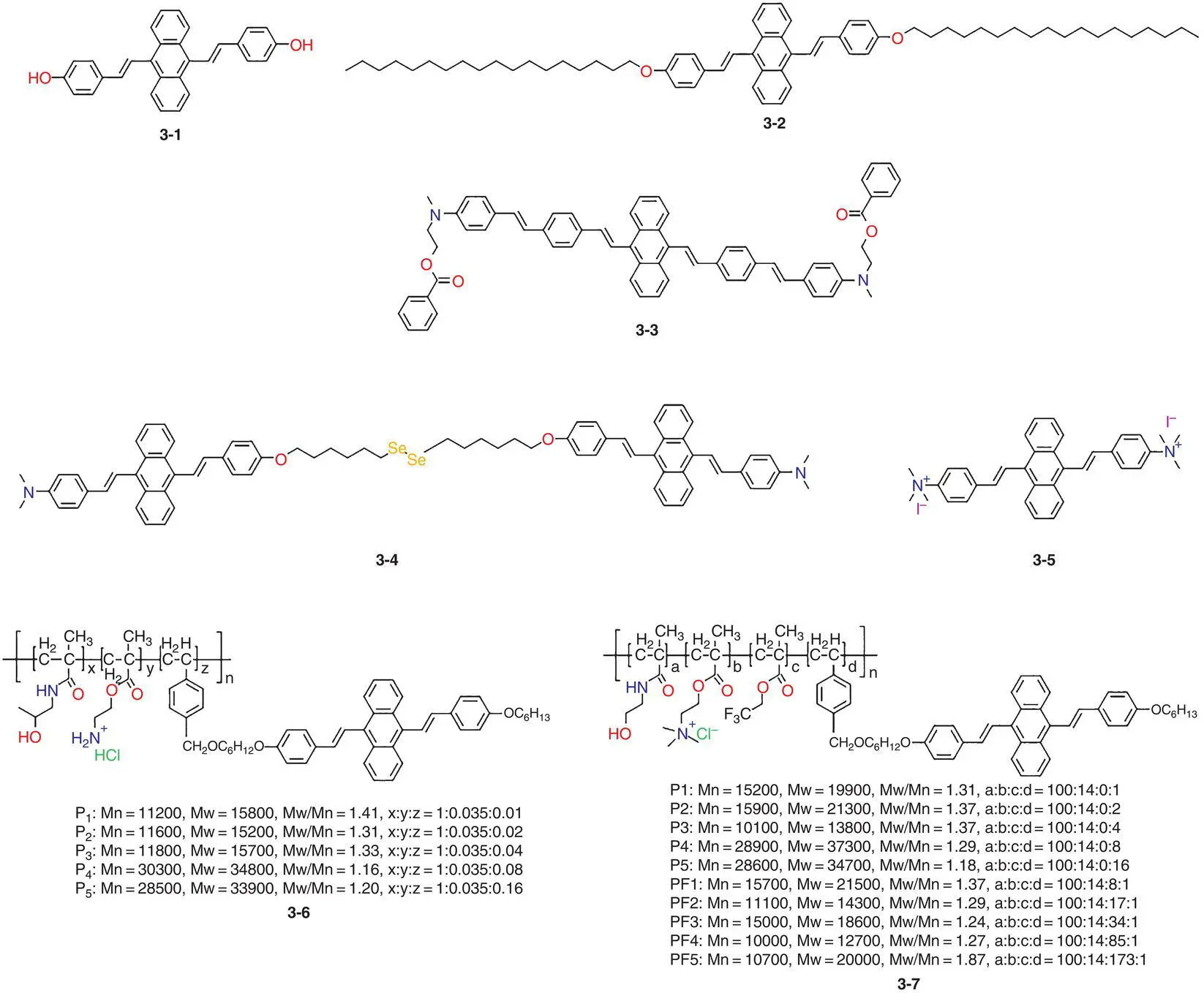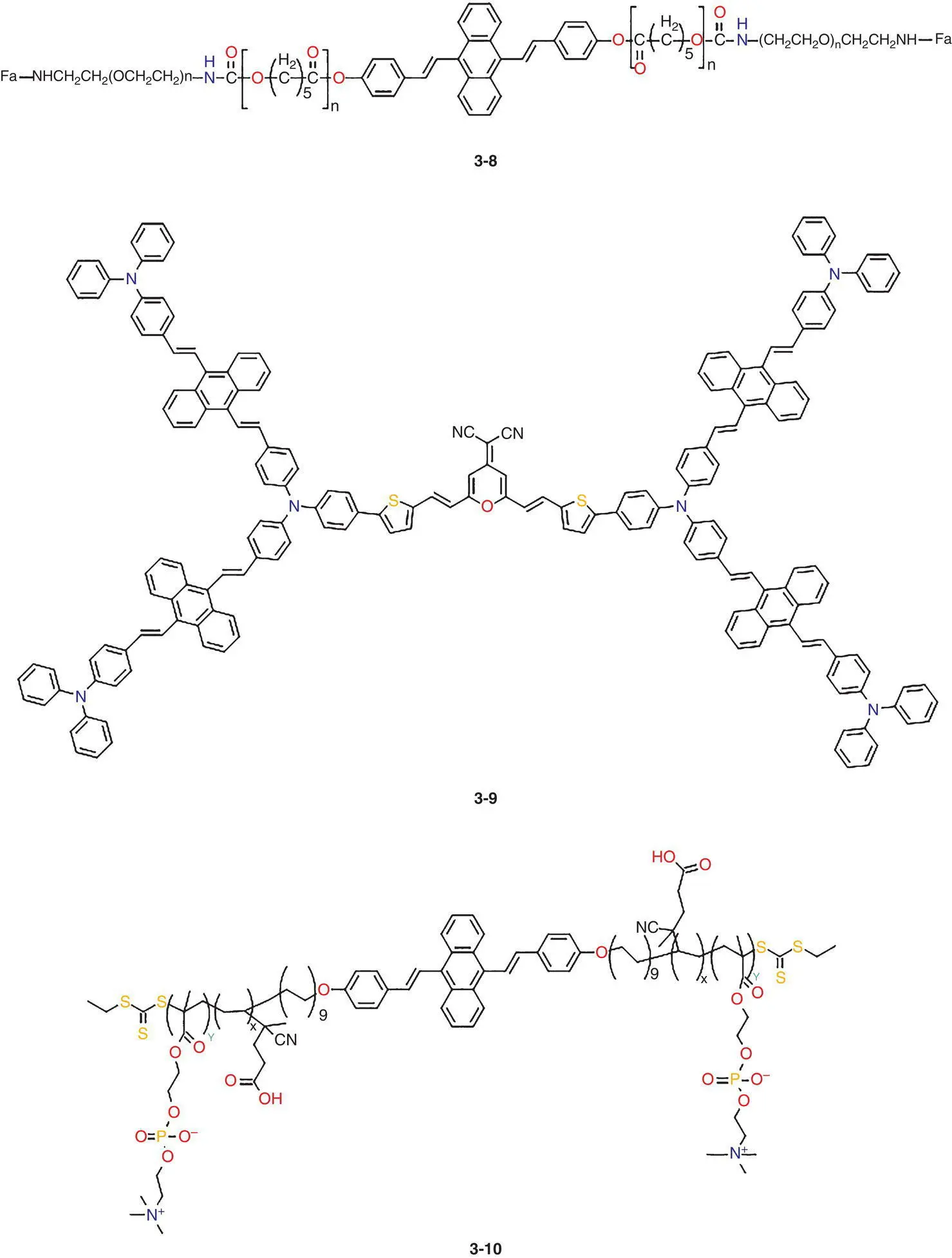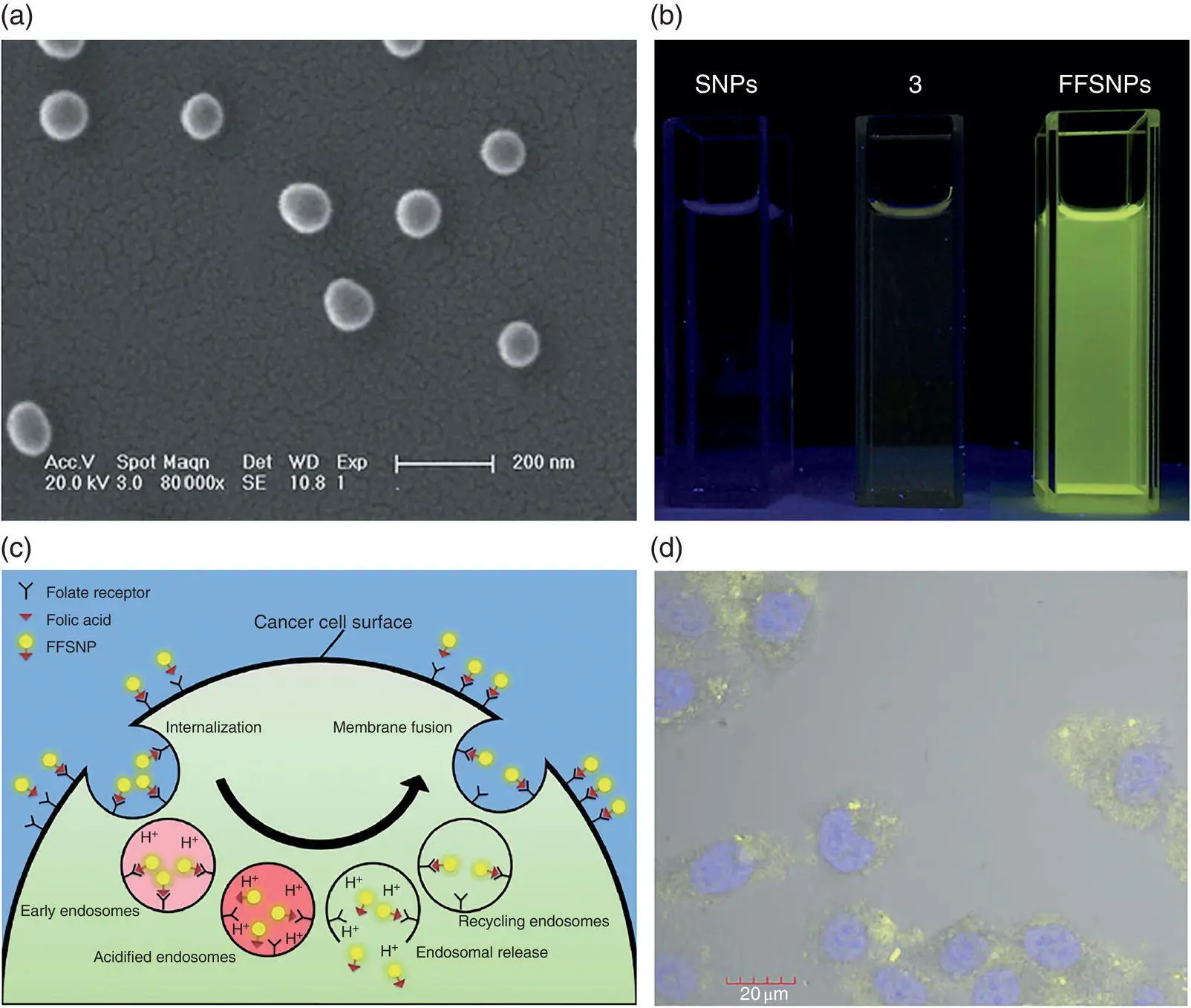Three conjugated oligocarbazoles in 2‐15(molecules with n = 1, 2, 3 named as Cz2, Cz4, and Cz6, respectively) with a DSA core were synthesized by Tian's group. It was found that the molecules in 2‐15exhibited the transition from AIE to AEE behavior with increasing the conjugation length. Self‐assembly of the Cz4 molecule gave rise to nanorings with a high fluorescent efficiency (see Figure 2.7) [19].
An effective strategy to achieve large two‐photon action cross sections in the solid state was developed by designing a new series of dendrimers 2‐16based on DSA and triphenylamine. When the dendrimer molecules aggregate in the mixed solutions or thin films, the intramolecular rotations are restricted and the molecules become more planar due to the stacking forces and intermolecular interactions, which causes an increase in the emission efficiency and a red‐shift in the emission color. These dendrimers presented enhanced fluorescence in the nanoaggregate or solid state, as well as AIE activity and large two‐photon action cross sections. The two‐photon action cross‐sectional values of these dendrimers increase with the generation number increasing [62].

Figure 2.7 Aggregation emission properties and self‐assembly of conjugated oligocarbazoles 2‐15[19].
Source : Reproduced from Ref. [19] with permission from the Royal Society of Chemistry.
From the above investigation results, it can be observed that the specific molecular packing plays important roles in achieving enhanced fluorescence emission for these AIE molecules in the aggregation state. Radhakrishnan et al. quantitatively assessed the relevance of molecular packing in terms of intermolecular energy transfer. They reported quantitative explorations of the correlation between molecular assembly and fluorescence efficiency enhancement [63–67].
2.2.3 Fluorescent Materials for Bioimaging
Fluorescence bioimaging is one of the most powerful bioimaging techniques for real‐time, noninvasive monitoring biomolecules of interest in their native environments with high spatial and temporal resolution. The development of fluorescent probes has facilitated the recent significant advances in cell biology and medical diagnostic imaging [68, 69]. Figure 2.8shows some small molecules and macromolecules based on DSA applied in fluorescent bioimage.
Tian et al. reported a kind of highly emissive inorganic–organic nanoparticle with a core–shell structure for targeted cancer cell imaging [20]. The nanoparticles are coated with a folate‐functionalized silica shell, and DSA derivative 3‐1with AIE properties serves as the fluorescent core, affording the folate‐functionalized fluorescent silica nanoparticles (FFSNPs) with a high fluorescence quantum yield (up to 20%). The FFSNPs have a small size whose diameter is ~60 nm (see Figure 2.9a), and they are monodispersed, stable in aqueous suspension. Whereas the solution of 3‐chloropropyltriethoxysilane (CPS)‐DSA adduct 3and the suspensions of silica nanoparticles (SNPs) almost have no light emission under UV illumination, an intense yellow light is emitted from FFSNPs (see Figure 2.9b). In addition, the FFSNPs have low toxicity to living cells and thus are suitable to be utilized for targeted HeLa cell imaging (see Figure 2.9c, d) [20].
Wei et al. reported that luminescent silica nanoparticles could be easily fabricated by encapsulating an AIE dye 3‐2(named An18) via a modified Stöber method [70]. In this method, octadecyltrimethoxysilane (C18‐Si) and 3‐2were first self‐assembled and served as the core of the silica nanoparticles. Then, another silicate precursor, tetraethoxysilane, was further coated on the luminescent core, thus forming luminescent silica nanoparticles. The results demonstrated that An18‐SiO 2nanoparticles have a uniform spherical morphology with a diameter of 70–80 nm. In addition, they exhibited high water dispersibility, remarkable fluorescent properties, and excellent biocompatibility, which makes them a promising candidate material for various biomedical applications. Moreover, they also facilely prepared water‐soluble and biocompatible fluorescent organic nanoparticles based on the AIE molecule 3‐2by mixing 3‐2and surfactant; further, such fluorescent organic nanoparticles were also utilized in cell imaging [71].


Figure 2.8 Small molecules and macromolecules of DSA derivatives applied in bioimage.
Prasad et al. prepared organically modified silica nanoparticles of ~30 nm, which are stably dispersible in aqueous solution [72]. The nanoparticles were fabricated by coencapsulating a photosensitizing anticancer drug 3‐(4‐hydroxyphenyl)propionic acid hydrazide (HPPH) and fluorescent aggregates of a two‐photon absorbing dye 3‐3. The results indicated that the dye 3‐3aggregates can efficiently upconvert the energy of near‐IR light and transfer it to the coencapsulated HPPH molecules via the fluorescence resonance energy transfer (FRET) mechanism, which leads to the enhanced two‐photon generation of singlet oxygen in water. Therefore, the prepared nanoparticles in this work can be applied in the two‐photon photodynamic therapy. In addition, they prepared a kind of silicon dioxide nanoparticle with high luminescence using the AIE compound 3‐3through the aggregation‐enhanced fluorescence approach, and two‐photon fluorescence imaging was performed on HeLa cells [73].

Figure 2.9 (a) Scanning electron microscopy (SEM) images of monodispersed folate‐functionalized fluorescent silica nanoparticles (FFSNPs) with particle sizes around 60 nm; (b) solution of 3‐chloropropyltriethoxysilane (CPS)‐DSA adduct 3and suspensions of silica nanoparticles (SNPs) and FFSNPs in ethanol; photograph taken upon irradiation with a UV light of 365 nm; (c) folate‐mediated delivery of FFSNPs to folate receptor‐positive cancer cells. A fraction of the FFSNPs will traffic into the cancer cells by receptor‐mediated endocytosis (left side of the figure), while the remainder will remain on the cell surfaces (right side of the figure); two types of strategies can be envisioned: (d) confocal fluorescence images of FFSNPs for HeLa cells: overlay of fluorescence image and bright‐field image [20].
Source : Reproduced from Ref. [20] with permission from the Royal Society of Chemistry.
Tian et al. successfully designed and synthesized a novel fluorescent molecule 3‐4based on a diselenide bond and DSA AIEgens. The compound 3‐4can self‐assemble into uniform nanoparticles via the generally used nanoprecipitation method, and the nanoparticles emit a bright orange fluorescence. The redox‐responsive fluorescent nanoparticles based on the diselenide bond and DSA AIEgens have potential applications in cell imaging and reduction‐sensitive drug delivery for selective cancer therapy [74].
Читать дальше
















